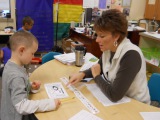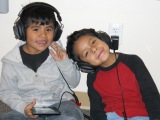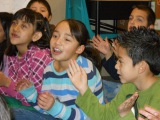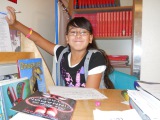-
Category 2
Selected in 2012
-
Grades: k - 5
School Setting: rural
Town Population: 1,557
Student Enrollment: 210
Student Demographics:
Black/African American: 0%
Teacher/Student Ratio: 1:21
White/Caucasian: 20%
Hispanic: 78%
Hawaiian/Pacific Islander: 0%
Asian: 1%
Native American: 1%
Other: 0%
% Reduced Lunch: 100%
% ELL Learners: 50%
Founded: 1903 -
PRINCIPAL:
Jeff Dillon -
CONTACT:
210 A Ave E
Wilder, ID 83676
(208) 482-6220
jdillon@wilderschools.org
Wilder Elementary School
Wilder, ID
Data drives our curriculum, instruction and assessment practices. Teachers write an individual learning plan for EVERY student. These plans include intervention needs to enrichment opportunities that are based on data, from not only on-going observations, but a multitude of district and state assessments. This data is also posted in our intervention room on the “Data Wall”.
- Describe specific programs in place to ensure that families are involved in the success of your school and students.
-
• Monthly awards assemblies focused on student achievement.
• Parent Partnership Committee development.
• Spanish and English classes offered once a year to families.
• Focused parent/teacher conferences on working as a team to help support the learning needs of the student.
• Annual All School 5 Kilometer Fun Run for Education to promote healthy family activities and nutrition.
• 100% increase in parent involvement/engagement in all aspects of the school’s mission and vision. - Describe the most successful activity your school has initiated to strengthen the ties to your community.
- Two years ago our school partnered with the Parent Partnership Committee to raise money for the technology needs in our school and to support healthier family activities through a 5 Kilometer Fun Run for Education. Thirty percent of our community’s population has participated in this incredible event each year.
- Describe your philosophy of school change or improvement.
-
Phase 1.
• People buy into the leader then the vision… A goal-driven vision of shared leadership.
Phase 2.
• Allowing students to remain below proficiency levels in any content areas is NOT an option, teacher must adapt and overcome!
Phase 3.
• Rigor, Relevance, and Relationships (Built on Trust) - Teachers teach kids - programs don’t.
Phase 4.
• Building instructional capacity through high quality professional development of teachers is an ongoing process.
Each phase in the philosophical change is embedded in the Nine Characteristics of High Performing Schools. - What are your school’s top two goals for the next year?
- Full implementation of Common Core State Standards with aligned Benchmark assessments and to continue deeply aligned thematic units that are taught with local curricular, assessment, expectations, and fidelity.
- What is the single most important factor in the success of your school that others could replicate?
- Leadership which is not built around a vision is not true leadership. The most important factor of success in our school, that truly can be replicated, is a leadership with a passion and vision for excellence in teaching and learning. This vision created a total transformation change in every aspect of our daily operation and planning. When the student truly became the center of our attention, the way we viewed and carried out our daily practices changed. When accountability became visible to all, at all times, differentiation of instruction, collaboration and collegiality became the norm.
- Describe the program or initiative that has had the greatest positive effect on student achievement.
- It was the fundamental belief that teachers teach children - programs don’t. Combined with the understanding that we inspect what we expect. With this philosophy, the initiative built a greater capacity for excellent instructional practices by all teachers. In order to fulfill what was a void in our school quickly, efficiently and sustainable, a partnership was established with two professors from Boise State University’s Literacy Department and an independent education consultant for math and science. These partnerships have afforded us the ability to provide a dynamic capacity for differentiated instructional practices that include, but are not limited to Thematic Instructional Literacy Techniques, Sheltered Instruction Observation Protocol, Balanced Literacy, and Mathematical Thinking for Instruction. With a passion for excellent instruction, data is used to drive lesson/unit planning in the content areas from intervention to enrichment.
- Explain how Title I funds have supported your improvement efforts.
- We use our Title 1 funds for three primary areas of focus. Data driven professional development for literacy, math and science instruction. Successful implementation of a Response to Intervention model for all students from kindergarten through 5th grade, where the best teachers work with the neediest students. As well as the addition of a Family Liaison Facilitator that fully demonstrates and characterizes the “how to” in parent engagement.
- Identify the professional development activities you use to improve the teaching portion of the teaching and learning process.
-
• Creating a level of trust between staff, this provides the ability to maximize each professional development opportunity.
• Developing the capacity in staff to differentiate instruction in all subjects.
• Implementation of Thematic Instructional Literacy Techniques (TILT). TILT are purposefully placed strategies/techniques within a unit of study that ensures integrated content, understanding and retention of the subject matter.
• Establishing Professional Learning Communities that function according to common expectations with predictable outcomes. These outcomes include peer observations and collaboration.
• Rewriting curriculum to better meet the needs of our students.
• Conducting weekly observations with immediate feedback.
• Understanding and analyzing data to drive daily instructional decisions. - Describe how data is used to improve student achievement and inform decision making.
- Data drives our curriculum, instruction and assessment practices. Teachers write an individual learning plan for EVERY student. These plans include intervention needs to enrichment opportunities that are based on data, from not only on-going observations, but a multitude of district and state assessments. This data is also posted in our intervention room on the “Data Wall”. The Data Wall is updated monthly during our professional development time. At this event, teachers, along with their colleagues, celebrate the growth that is being made by each student.
- Describe your school culture and explain changes you’ve taken to improve it.
-
It was apparent that expectations for colleagues and strategies for student learning were missing. Truly a culture paradigm shift was needed for everyone. Teachers taught in isolation, and often falsified data and grades. There was a lack of an understanding for high expectations for their selves and their students. There was not one area left unchanged.
• Teacher to Teacher and Student to Student accountability. All students and staff demonstrate daily: respect for the truth, respect for self, respect for others, and respect for property. Office discipline referrals have been reduced by 95% over the past four years.
• Students are engaged in learning and enjoy doing so. Homework is being completed more often than not. Reading at home is a pleasure for most students.
• Infused in all staff is the fundamental belief that ALL students can and will learn when I (the teacher) have prepared and created the optimal learning environment.
• Collaboration happens all the time, not just when it is scheduled.
• Students deserve the best and nothing less.
• We go beyond “buy in”; rather we “sell out” based on synergy around student learning and success.
• Every moment is a teachable moment. We create teachable moments; we don’t wait for them to happen.
• Created Intervention classrooms staffed with the most effective teachers.
Stats
-
Category 2
Selected in 2012
-
Grades: k - 5
School Setting: rural
Town Population: 1,557
Student Enrollment: 210
Student Demographics:
Black/African American: 0%
Teacher/Student Ratio: 1:21
White/Caucasian: 20%
Hispanic: 78%
Hawaiian/Pacific Islander: 0%
Asian: 1%
Native American: 1%
Other: 0%
% Reduced Lunch: 100%
% ELL Learners: 50%
Founded: 1903 -
PRINCIPAL:
Jeff Dillon -
CONTACT:
210 A Ave E
Wilder, ID 83676
(208) 482-6220
jdillon@wilderschools.org








